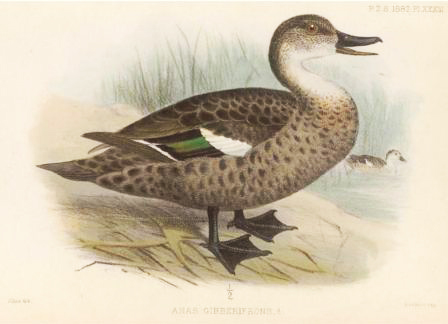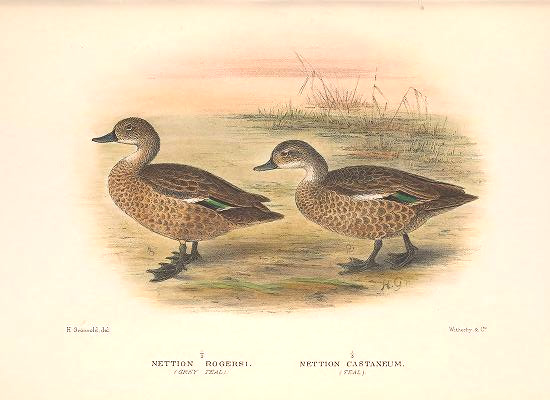


Grey Teal from Proceedings of the Zoological Society, 1882.
These ducks breed only in Australia and New Zealand. According to Heather and Robertson, in New Zealand they were rare until the 1950s when several irruptions from Australia occurred. With some encouragement with nestings boxes, the population radily increased.
However, Sir Walter Lawry Buller reported in 1879 that the grey teal was plentiful in Lake Rotomahana in the Bay of Plenty but that was before the eruption of Mount Tarawera in 1886.


Grey Teal, Tētē-moroiti and Teal from Birds of Australia, Mathews, Gregory, 1910-1927.
| Taxonomy | |
|---|---|
| Kingdom: | Animalia |
| Phylum: | Chordata |
| Class: | Aves |
| Order: | Anseriformes |
| Family: | Anatidae |
| Genera: | Anas |
| Species: | gracilis |
| Sub Species: |
Anas gibberifrons gracilis.
Native bird
43 cm., males 525 g., females 425 g., light brown with pale grey cheeks chin and foreneck, bill blue grey, eye red, speculum blue-green with prominent white triangle in flight.
Common in shallow coastal lakes and lagoons South Auckland and northern Waikato, Hawke’s Bay, Manawatu, Wairarapa and eastern South Island from Marlborough to Southland.
He Kōtuku rerenga tahi.
A Kōtuku’s flight is seen but once.
Nga kōtuku awe-nui o te uru
Ka moe whakaaio ki te mate.
The long-plumed white herons of the west sleep peacefully in death.
David Alexander
Proceedings of the Zoological Society, 1882.
Birds of Australia, Mathews, Gregory, 1910-1927.
Heather, B., & Robertson, H., Field Guide to the Birds of New Zealand, 2000.
Oliver, W.R.B. New Zealand Birds, 1955.
Buller, Walter Lawry, Birds of New Zealand, 1888.
Monday, 4 September, 2023; ver2023v1